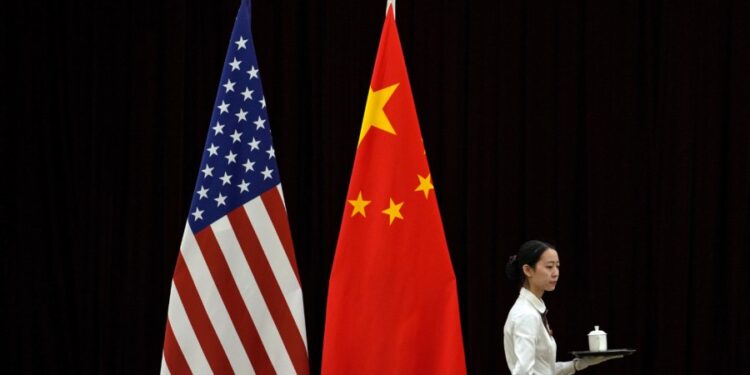
President Trump’s tariffs in China are in place and hitting all products imported from the country — including a number of pharmaceutical drugs that Americans rely upon.
Chinese imports account for a significant proportion of U.S. prescriptions and over the counter drugs. Many of the Chinese-produced drugs are generics, which account for 91 percent of prescriptions dispensed in the U.S.
“The Chinese market is a key supplier for key starting materials and [Active Pharmaceutical Ingredient (API)] to the generic supply chain,” said John Murphy, president and CEO of the Association for Accessible Medicines (AAM).
“I will say they’re sort of less important any longer for the actual finished fill and final manufacturing,” Murphy noted. “But really, it’s the rare minerals, the key starting materials which are obviously critical to the supply chain.”
Stakeholders were hopeful that medications would be spared from tariffs. Some noted that the U.S. is a signatory to the World Trade Organization’s (WTO) 1994 Agreement on Trade in Pharmaceutical Products which calls for the elimination of tariffs on many pharmaceutical products. China has vowed to sue over the 10 percent tariffs, which it says are in violation of WTO rules.
But a White House official who spoke with The Hill said no exceptions are planned, and the administration will not be recognizing the WTO agreement.
U.S. relies on China
The country’s dependence on China to maintain pharmaceutical supply chains has long been an issue that lawmakers on both sides of the aisle have sought to address.
In 2018, the U.S.-China Economic and Security Review Commission noted that the country was “heavily dependent” on drugs and API originating from China. A 2023 analysis from the Atlantic Council found that the value of Chinese-imported APIs has continued to grow in recent years.
According to Monica de Bolle, a senior fellow at the Peterson Institute for International Economics, the U.S. isn’t unique in its dependence on China for drugs, noting that the European Union is similarly reliant.
De Bolle said China’s dominance in the market grew as it sought to enhance its drug producing capacity while U.S. pharmaceutical companies turned to other manufacturing pursuits.
“What happened is that we developed this huge biotech sector where we have a lot of stuff going on,” said de Bolle. “The manufacturing market just turned to producing these more sophisticated drugs; the stuff that’s used in treatments, the stuff that’s going through clinical trials.”
“That’s why we went from, you know, producing a lot of these things to not producing many of these things and buying them from elsewhere. And elsewhere eventually became China,” she added.
Tariffs may cause shortages, industry exits
The margins for manufacturing generic drugs are razor-thin, and any disruptions to the supply chain are apt to cause shortages or delays.
“That additional 10 percent tariff is going to have a fairly significant impact on the cost of goods for the generic and by a similar supply chain,” said Murphy. “We don’t hold massive stockpiles of generic drugs in the United States. It’s a fairly just-in-time inventory.”
According to Murphy, some manufacturers may find it economically unviable to produce generic drugs, resulting in shortages.
Across all industries, analysts have warned that increased costs brought on by tariffs will be passed to consumers. But some manufacturers may instead drop out of the market entirely rather than pass on costs, partly due to a key provision in the Inflation Reduction Act (IRA).
As part of its cost-cutting measures, the IRA included a provision that requires drugmakers to pay Medicaid a rebate if the price of their drugs rises faster than the rate of inflation.
Tom Kraus, vice president of government relations at the American Society of Health-System Pharmacists, said incurring that penalty on top of tariffs could mean more than just shortages.
“You’ve got to sort of factor in paying that penalty, which is going to make you less profitable or you’re going to have to drop out of the market,” said Kraus.
He noted that group purchasing organizations, companies that help hospitals and pharmacies buy drugs and save money, may decide that manufacturers whose products originate from China are too expensive and turn away from them entirely.
Eyes turn to India
India is also a global powerhouse when it comes to API manufacturing. An analysis by the United States Pharmacopeia (USP) found that India in 2023 had 50 percent of API drug master files (DMF), which are documents submitted to the Food and Drug Administration detailing the API manufacturing process.
While India has a slightly larger share of DMFs, China has gained more footing after increasing its share of DMFs by 63 percent between 2021 and 2023. While not all drugs use APIs that reference DMFs, they can indicate where API manufacturing is trending, USP noted.
But switching from China to India for sourcing is not something that can happen overnight.
“There’s plenty of this capacity in India, there’s plenty of this capacity in in the European Union and even Canada. I think that the problem is there is an excess capacity,” said Murphy. “You still are in a situation where it’s going to take some time to scale up additional surge capacity in any one of these places in order to meet the global demand.”
Not only is there the matter of time but Indian manufacturers don’t have the exact same capabilities as those in China.
“India does not make the range of stuff that China makes,” de Bolle said. “You can rely on India for some of the over-the-counter medications, you can rely on India for active ingredients that go into vaccines, you can rely on India for antibiotics to a degree.
“When you get into … the rest of it, then it becomes way more complicated,” she added. “And China is pretty much the only market out there.”






